Guiquan Liu
ChemEval: A Comprehensive Multi-Level Chemical Evaluation for Large Language Models
Sep 21, 2024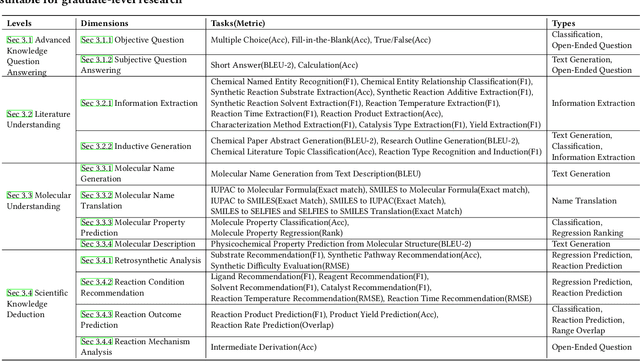
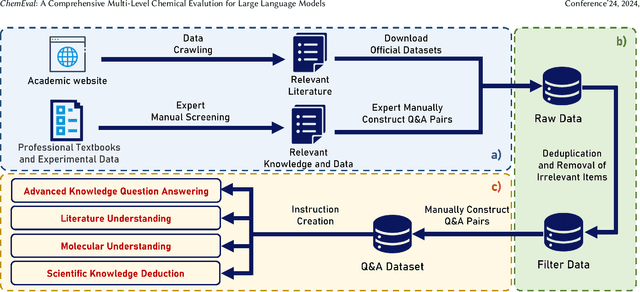


Abstract:There is a growing interest in the role that LLMs play in chemistry which lead to an increased focus on the development of LLMs benchmarks tailored to chemical domains to assess the performance of LLMs across a spectrum of chemical tasks varying in type and complexity. However, existing benchmarks in this domain fail to adequately meet the specific requirements of chemical research professionals. To this end, we propose \textbf{\textit{ChemEval}}, which provides a comprehensive assessment of the capabilities of LLMs across a wide range of chemical domain tasks. Specifically, ChemEval identified 4 crucial progressive levels in chemistry, assessing 12 dimensions of LLMs across 42 distinct chemical tasks which are informed by open-source data and the data meticulously crafted by chemical experts, ensuring that the tasks have practical value and can effectively evaluate the capabilities of LLMs. In the experiment, we evaluate 12 mainstream LLMs on ChemEval under zero-shot and few-shot learning contexts, which included carefully selected demonstration examples and carefully designed prompts. The results show that while general LLMs like GPT-4 and Claude-3.5 excel in literature understanding and instruction following, they fall short in tasks demanding advanced chemical knowledge. Conversely, specialized LLMs exhibit enhanced chemical competencies, albeit with reduced literary comprehension. This suggests that LLMs have significant potential for enhancement when tackling sophisticated tasks in the field of chemistry. We believe our work will facilitate the exploration of their potential to drive progress in chemistry. Our benchmark and analysis will be available at {\color{blue} \url{https://github.com/USTC-StarTeam/ChemEval}}.
Editing Knowledge Representation of Language Lodel via Rephrased Prefix Prompts
Mar 21, 2024



Abstract:Neural language models (LMs) have been extensively trained on vast corpora to store factual knowledge about various aspects of the world described in texts. Current technologies typically employ knowledge editing methods or specific prompts to modify LM outputs. However, existing knowledge editing methods are costly and inefficient, struggling to produce appropriate text. Additionally, prompt engineering is opaque and requires significant effort to find suitable prompts. To address these issues, we introduce a new method called PSPEM (Prefix Soft Prompt Editing Method), that can be used for a lifetime with just one training. It resolves the inefficiencies and generalizability issues in knowledge editing methods and overcomes the opacity of prompt engineering by automatically seeking optimal soft prompts. Specifically, PSPEM utilizes a prompt encoder and an encoding converter to refine key information in prompts and uses prompt alignment techniques to guide model generation, ensuring text consistency and adherence to the intended structure and content, thereby maintaining an optimal balance between efficiency and accuracy. We have validated the effectiveness of PSPEM through knowledge editing and attribute inserting. On the COUNTERFACT dataset, PSPEM achieved nearly 100\% editing accuracy and demonstrated the highest level of fluency. We further analyzed the similarities between PSPEM and original prompts and their impact on the model's internals. The results indicate that PSPEM can serve as an alternative to original prompts, supporting the model in effective editing.
Locating and Mitigating Gender Bias in Large Language Models
Mar 21, 2024Abstract:Large language models(LLM) are pre-trained on extensive corpora to learn facts and human cognition which contain human preferences. However, this process can inadvertently lead to these models acquiring biases and stereotypes prevalent in society. Prior research has typically tackled the issue of bias through a one-dimensional perspective, concentrating either on locating or mitigating it. This limited perspective has created obstacles in facilitating research on bias to synergistically complement and progressively build upon one another. In this study, we integrate the processes of locating and mitigating bias within a unified framework. Initially, we use causal mediation analysis to trace the causal effects of different components' activation within a large language model. Building on this, we propose the LSDM (Least Square Debias Method), a knowledge-editing based method for mitigating gender bias in occupational pronouns, and compare it against two baselines on three gender bias datasets and seven knowledge competency test datasets. The experimental results indicate that the primary contributors to gender bias are the bottom MLP modules acting on the last token of occupational pronouns and the top attention module acting on the final word in the sentence. Furthermore, LSDM mitigates gender bias in the model more effectively than the other baselines, while fully preserving the model's capabilities in all other aspects.
Hierarchy-Aware T5 with Path-Adaptive Mask Mechanism for Hierarchical Text Classification
Sep 17, 2021



Abstract:Hierarchical Text Classification (HTC), which aims to predict text labels organized in hierarchical space, is a significant task lacking in investigation in natural language processing. Existing methods usually encode the entire hierarchical structure and fail to construct a robust label-dependent model, making it hard to make accurate predictions on sparse lower-level labels and achieving low Macro-F1. In this paper, we propose a novel PAMM-HiA-T5 model for HTC: a hierarchy-aware T5 model with path-adaptive mask mechanism that not only builds the knowledge of upper-level labels into low-level ones but also introduces path dependency information in label prediction. Specifically, we generate a multi-level sequential label structure to exploit hierarchical dependency across different levels with Breadth-First Search (BFS) and T5 model. To further improve label dependency prediction within each path, we then propose an original path-adaptive mask mechanism (PAMM) to identify the label's path information, eliminating sources of noises from other paths. Comprehensive experiments on three benchmark datasets show that our novel PAMM-HiA-T5 model greatly outperforms all state-of-the-art HTC approaches especially in Macro-F1. The ablation studies show that the improvements mainly come from our innovative approach instead of T5.
Denoising User-aware Memory Network for Recommendation
Jul 12, 2021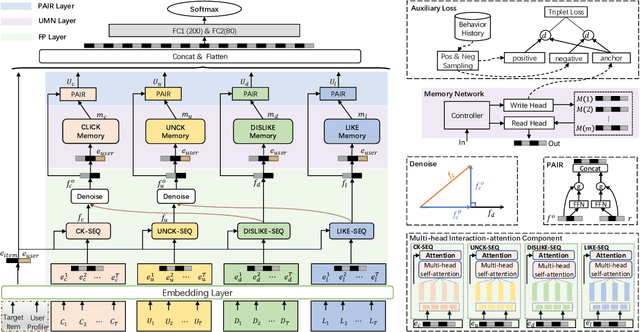
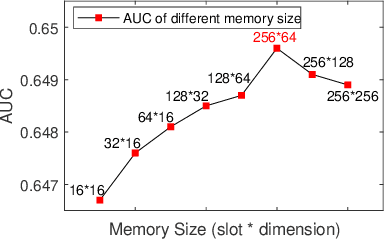

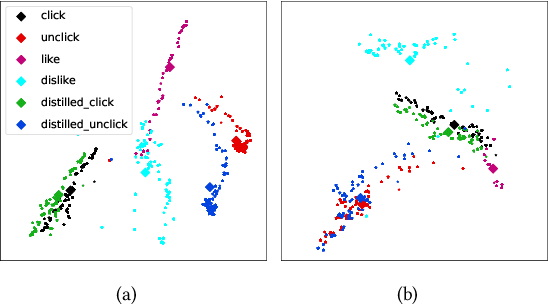
Abstract:For better user satisfaction and business effectiveness, more and more attention has been paid to the sequence-based recommendation system, which is used to infer the evolution of users' dynamic preferences, and recent studies have noticed that the evolution of users' preferences can be better understood from the implicit and explicit feedback sequences. However, most of the existing recommendation techniques do not consider the noise contained in implicit feedback, which will lead to the biased representation of user interest and a suboptimal recommendation performance. Meanwhile, the existing methods utilize item sequence for capturing the evolution of user interest. The performance of these methods is limited by the length of the sequence, and can not effectively model the long-term interest in a long period of time. Based on this observation, we propose a novel CTR model named denoising user-aware memory network (DUMN). Specifically, the framework: (i) proposes a feature purification module based on orthogonal mapping, which use the representation of explicit feedback to purify the representation of implicit feedback, and effectively denoise the implicit feedback; (ii) designs a user memory network to model the long-term interests in a fine-grained way by improving the memory network, which is ignored by the existing methods; and (iii) develops a preference-aware interactive representation component to fuse the long-term and short-term interests of users based on gating to understand the evolution of unbiased preferences of users. Extensive experiments on two real e-commerce user behavior datasets show that DUMN has a significant improvement over the state-of-the-art baselines. The code of DUMN model has been uploaded as an additional material.
LRC-BERT: Latent-representation Contrastive Knowledge Distillation for Natural Language Understanding
Dec 14, 2020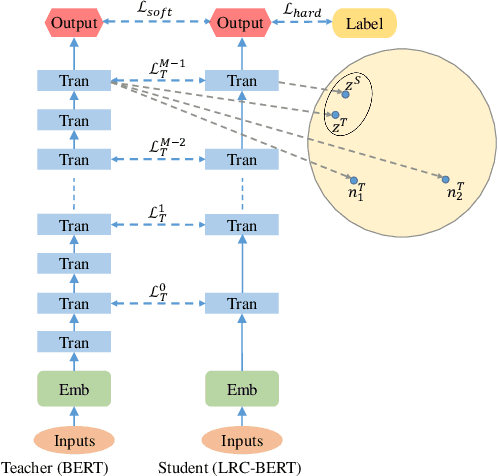

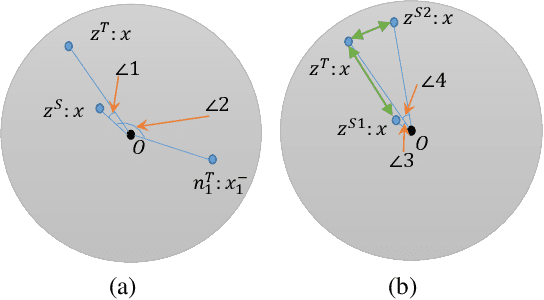

Abstract:The pre-training models such as BERT have achieved great results in various natural language processing problems. However, a large number of parameters need significant amounts of memory and the consumption of inference time, which makes it difficult to deploy them on edge devices. In this work, we propose a knowledge distillation method LRC-BERT based on contrastive learning to fit the output of the intermediate layer from the angular distance aspect, which is not considered by the existing distillation methods. Furthermore, we introduce a gradient perturbation-based training architecture in the training phase to increase the robustness of LRC-BERT, which is the first attempt in knowledge distillation. Additionally, in order to better capture the distribution characteristics of the intermediate layer, we design a two-stage training method for the total distillation loss. Finally, by verifying 8 datasets on the General Language Understanding Evaluation (GLUE) benchmark, the performance of the proposed LRC-BERT exceeds the existing state-of-the-art methods, which proves the effectiveness of our method.
Privacy Preserving PCA for Multiparty Modeling
Feb 09, 2020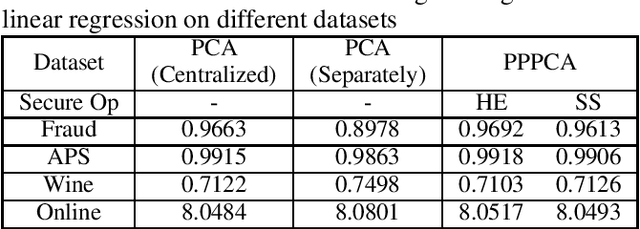


Abstract:In this paper, we present a general multiparty modeling paradigm with Privacy Preserving Principal Component Analysis (PPPCA) for horizontally partitioned data. PPPCA can accomplish multiparty cooperative execution of PCA under the premise of keeping plaintext data locally. We also propose implementations using two techniques, i.e., homomorphic encryption and secret sharing. The output of PPPCA can be sent directly to data consumer to build any machine learning models. We conduct experiments on three UCI benchmark datasets and a real-world fraud detection dataset. Results show that the accuracy of the model built upon PPPCA is the same as the model with PCA that is built based on centralized plaintext data.
 Add to Chrome
Add to Chrome Add to Firefox
Add to Firefox Add to Edge
Add to Edge